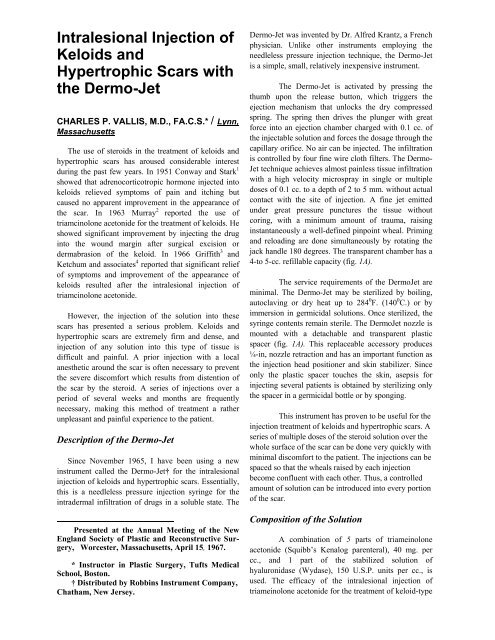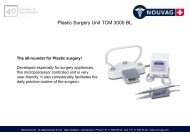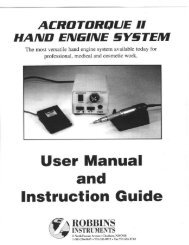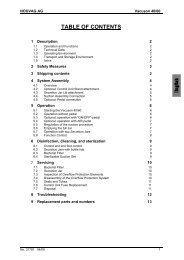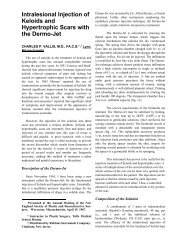Intralesional Injection of Keloids and Hypertrophic Scars with the ...
Intralesional Injection of Keloids and Hypertrophic Scars with the ...
Intralesional Injection of Keloids and Hypertrophic Scars with the ...
Create successful ePaper yourself
Turn your PDF publications into a flip-book with our unique Google optimized e-Paper software.
Clinical ResultsRelief <strong>of</strong> symptoms.An analysis <strong>of</strong> <strong>the</strong> 4 patients seeking onlyrelief <strong>of</strong> symptoms proved interesting.1. A 38-year-old woman had had a hysterectomythrough a lower vertical mid-abdominalincision 2 years previously. She developed araised, hypertrophic, reddish brown scarmeasuring 2 in. by 9 in. The scar wasextremely sensitive <strong>and</strong> painful. She wasunable to wear a girdle or o<strong>the</strong>r tight clothingover <strong>the</strong> scarred area. The entire scar wasinjected <strong>with</strong> <strong>the</strong> Dermo-Jet initially, <strong>and</strong> <strong>the</strong>patient had complete relief <strong>of</strong> symptoms <strong>with</strong>in48 hr. after <strong>the</strong> injection. The patientsubsequently had 2 additional series <strong>of</strong>injections <strong>with</strong> complete flattening <strong>of</strong> <strong>the</strong> scar<strong>and</strong> permanent cessation <strong>of</strong> <strong>the</strong> symptoms.2. A 70-year-old man had had a colon resectionthrough a lower vertical mid-abdominalincision 10 months previously. He developed araised, painful, hypertrophic, reddish brownscar measuring % in. by9 in. This patient alsohad complete relief <strong>of</strong> symptoms after <strong>the</strong>initial injection. He subsequently had 2additional series <strong>of</strong> injections <strong>with</strong> completeflattening <strong>of</strong> <strong>the</strong> scar.3. A 42-year-old woman had a similar raisedhypertrophic scar on <strong>the</strong> right flank resultingfrom a nephrectomy operation 18 monthspreviously. This patient was very apprehensive<strong>and</strong> had been under psychiatric care for adepressed state. This scar measured 3/8 in. by8 in. Her symptoms were relieved after 2 series<strong>of</strong> injections. A major portion <strong>of</strong> her scar wasflattened. This patient was one <strong>of</strong> a few whocomplained <strong>of</strong> severe pain during <strong>the</strong> injection<strong>and</strong> also persistent burning pain for severalhours after <strong>the</strong> injection.4. A 19-year-old girl complained <strong>of</strong> severe painto pressure over a small localized area <strong>of</strong>subcutaneous scarring on <strong>the</strong> sole <strong>of</strong> <strong>the</strong> leftfoot following removal <strong>of</strong> a plantar wart 2years previously. This patient had 1 injection<strong>with</strong> <strong>the</strong> Dermo-Jet. The scar s<strong>of</strong>tened <strong>and</strong>completely disappeared <strong>with</strong> cessation <strong>of</strong>symptoms <strong>with</strong>in a month after treatment.Of <strong>the</strong> o<strong>the</strong>r 10 <strong>with</strong> symptoms, 9 hadcomplete relief <strong>of</strong> symptoms <strong>with</strong>in 48 hr. after <strong>the</strong>initial series <strong>of</strong> injections. The remaining patient was a33-year-old woman <strong>with</strong> multiple hypertrophic scars on<strong>the</strong> palm <strong>of</strong> <strong>the</strong> left h<strong>and</strong> resulting from a crush injury 5months previously. She had 5 series <strong>of</strong> injections <strong>with</strong>s<strong>of</strong>tening <strong>and</strong> leveling <strong>of</strong> <strong>the</strong> scars <strong>and</strong> markedimprovement <strong>of</strong> symptoms. She still complained <strong>of</strong>moderate pain to pressure over a tight scar on <strong>the</strong>proximal crease <strong>of</strong> <strong>the</strong> palm.Appearance <strong>of</strong> <strong>the</strong> scarAnalysis <strong>of</strong> <strong>the</strong> appearance <strong>of</strong> <strong>the</strong> scars afterinjection indicated a very favorable response to <strong>the</strong><strong>the</strong>rapy. Nine patients are still under treatment. Of <strong>the</strong>remaining 19 patients, 14 had complete leveling <strong>of</strong> <strong>the</strong>keloid or hypertrophic scars. Of <strong>the</strong> 14, 4 were smallkeloids averaging 1,4 in. in diameter resulting fromvaccination. The o<strong>the</strong>r 10 were hypertrophic scarsresulting from surgery or injury. Of <strong>the</strong> 5 <strong>of</strong> <strong>the</strong> 19 whoshowed incomplete leveling <strong>of</strong> <strong>the</strong> scar, 2 had 80 to 90per cent leveling.1. The patient was a 17-year-old girl <strong>with</strong> a largerecurrent keloid on <strong>the</strong> left shoulder measuring2½ in. in diameter. It was <strong>of</strong> 3 years’ duration<strong>and</strong> resulted from <strong>the</strong> surgical excision <strong>and</strong>graft <strong>of</strong> ano<strong>the</strong>r keloid resulting fromvaccination. X-ray <strong>the</strong>rapy was also given at<strong>the</strong> time <strong>of</strong> <strong>the</strong> surgical excision. She had atotal <strong>of</strong> 8 series <strong>of</strong> injections over a period <strong>of</strong>10 months.2. An 18-year-old boy had a keloid over <strong>the</strong> leftmastoid area resulting from a car accident. Thescar measured 3/8 in. by 1 in. He had a total <strong>of</strong>3 series. Three showed a 60 to 75 per centleveling <strong>of</strong> <strong>the</strong> scar.3. A 21-year-old man had multiple keloids on hischest resulting from acne. Hehad a total <strong>of</strong> 7 series <strong>of</strong> injections.4. A 42-year-old woman had a hypertrophic scaron <strong>the</strong> right flank following a nephrectomy.She had a total <strong>of</strong> 2 series <strong>of</strong> injections.5. A 14-year-old boy had a large keloid on <strong>the</strong>left side <strong>of</strong> <strong>the</strong> neck resulting from injury. Hehad had a surgical excision <strong>with</strong> Z-plastyrepair 1 year previously <strong>with</strong> markedrecurrence <strong>of</strong> <strong>the</strong> keloid which measured 1 1/2in. by 5 in. He had a total <strong>of</strong> 10 series <strong>of</strong> injectionsover a period <strong>of</strong> 12 months <strong>with</strong> about75 per cent flattening <strong>of</strong> <strong>the</strong> scar.
Pain experienced during <strong>and</strong> after injection.The Dermo-Jet has proven itself to be a veryuseful instrument in <strong>the</strong> injection treatment <strong>of</strong> keloid<strong>and</strong> hypertrophic scars primarily because <strong>of</strong> <strong>the</strong> ease <strong>of</strong>administration. <strong>of</strong> <strong>the</strong> drug. No form <strong>of</strong> anes<strong>the</strong>sia isnecessary <strong>with</strong> <strong>the</strong> Dermo-Jet.A controlled amount <strong>of</strong> solution is given <strong>with</strong>each injection, <strong>and</strong> <strong>the</strong>re is visible evidence in <strong>the</strong> form<strong>of</strong> pale white wheals to indicate whe<strong>the</strong>r <strong>the</strong> entire scarhas been injected. An analysis <strong>of</strong> <strong>the</strong> amount <strong>of</strong> painresulting from <strong>the</strong> injections <strong>with</strong> <strong>the</strong> Dermo-Jet provedinteresting. I have used this instrument on myself <strong>and</strong>some <strong>of</strong> my fellow workers. The pain noted during <strong>the</strong>injection into normal skin on <strong>the</strong> arm was minimal <strong>and</strong>insignificant. It felt like a tiny transient “pinch” in <strong>the</strong>skin. There was no after pain.Of <strong>the</strong> 27 patients treated, 18 complained <strong>of</strong>minimal or insignificant pain during <strong>the</strong> injection. Moststated that it felt like a tiny mosquito bite, <strong>and</strong> <strong>the</strong>ywere able to tolerate several injections during eachseries <strong>with</strong>out any complaint. Six complained <strong>of</strong>moderate pain <strong>with</strong> <strong>the</strong> initial series <strong>of</strong> injections. Theydescribed it as a momentary sting. They were also ableto tolerate multiple injections, <strong>and</strong> most <strong>of</strong> <strong>the</strong>m hadminimal pain <strong>with</strong> subsequent injections. Threecomplained <strong>of</strong> severe pain during <strong>the</strong> injection.1. A 21-year-old girl had a large keloid burn scar<strong>of</strong> <strong>the</strong> right cheek <strong>of</strong> 7 months’ duration. Thispatient had had a total <strong>of</strong> 6 previous Kenaloginjections <strong>with</strong> a needle <strong>and</strong> syringe <strong>and</strong> alsoradiation <strong>the</strong>rapy elsewhere. She wasextremely agitated, <strong>and</strong> treatment had to besuspended after only a few injections <strong>with</strong> <strong>the</strong>Dermo-Jet. When this patient returned for hersecond treatment 1 month later, 1 part <strong>of</strong> 2 percent Xylocaine was added to <strong>the</strong> 6 parts <strong>of</strong>Kenalog <strong>and</strong> Wydase. She was assured that <strong>the</strong>pain would be negligible, <strong>and</strong> she was able totolerate about 15 injections <strong>with</strong> only minimalto moderate complaints <strong>of</strong> pain.2. A 42-year-old maiden lady had a painfulhypertrophic scar on <strong>the</strong> right flank 18 monthsafter a nephrectomy. She had been underpsychiatric treatment for a chronic depressedstate. This patient stated that <strong>the</strong> injectioncaused a sharp painful stinging sensation.However, she did tolerate 5 injections <strong>with</strong> <strong>the</strong>first series <strong>and</strong> <strong>the</strong>n came back a month laterfor a second series at which time she had 10injections. This patient also complained <strong>of</strong>persistent stinging pain in <strong>the</strong> scar for severalhours post injection.3. A 10-year-old boy had a large recurrenthypertrophic scar on his left arm measuring 1in. by 6 in. This boy had had 2 previousoperative procedures for gradual partialexcision <strong>of</strong> a much larger scar. He complained<strong>of</strong> severe pain during <strong>the</strong> multiple injections.He returned 1 month later for a second series<strong>of</strong> injections. Again, 1 part 2 per centXylocaine solution was added to 6 parts <strong>of</strong>Kenalog <strong>and</strong> Wydase, <strong>and</strong> this time hetolerated <strong>the</strong> treatment <strong>with</strong> minimal complaints<strong>of</strong> pain.Rees 6 has tried <strong>the</strong> Dermo-Jet for injectingKenalog solution into hypertrophic scars, <strong>and</strong> he hasnoted that his patients have complained <strong>of</strong> very severesensations <strong>of</strong> pain <strong>and</strong> burning in <strong>the</strong> scar for severalhours following treatment. In fact, he has found it morepainful than direct injection by needle. My experiencehas shown that <strong>the</strong> great majority <strong>of</strong> patients complain<strong>of</strong> minimal pain. I believe that <strong>the</strong> addition <strong>of</strong> <strong>the</strong>Wydase markedly lessens any post injection pain. Theaddition <strong>of</strong> a small amount <strong>of</strong> local anes<strong>the</strong>tic to <strong>the</strong>Kenalog solution would also diminish any post injectionpain in patients who complain initially. Reassurance <strong>of</strong><strong>the</strong>se patients <strong>and</strong> <strong>the</strong>ir acquaintance <strong>with</strong> thisinstrument before treatment help considerably in minimizingany discomfort.Discussion <strong>and</strong> SummaryThis paper has been principally written toacquaint <strong>the</strong> medical pr<strong>of</strong>ession <strong>with</strong> a useful newinstrument, <strong>the</strong> Dermo-Jet. The DermoJet has beenemployed for <strong>the</strong> intralesional steroid injection <strong>of</strong>keloids <strong>and</strong> hypertrophic scars in a total <strong>of</strong> 28 patients.A definite improvement evidenced by disappearance <strong>of</strong><strong>the</strong> symptoms <strong>and</strong> leveling or flattening <strong>of</strong> <strong>the</strong> scars wasnoted in all cases. Some scars showed a faster <strong>and</strong> morespectacular response than o<strong>the</strong>rs. The most dramatic responsewas noted in <strong>the</strong> hypertrophic scars resultingfrom surgery or injury. Complete flattening <strong>of</strong> <strong>the</strong>sescars resulted after only 1 to 4 series <strong>of</strong> injections.The true keloids, especially <strong>the</strong> larger ones, showed aslower response. S<strong>of</strong>tening <strong>and</strong> flattening proceededslowly, <strong>and</strong> a large number <strong>of</strong> doses were needed over alonger period <strong>of</strong> time. The small keloids resultingfrom vaccination showed a quick, dramatic response toonly 1 or 2 series <strong>of</strong> doses.In <strong>the</strong> hypertrophic operative scars <strong>of</strong> <strong>the</strong>abdomen, <strong>the</strong> principal complaint was burning pain <strong>and</strong>
itching. In <strong>the</strong>se patients, contact <strong>of</strong> <strong>the</strong>ir clothing over<strong>the</strong> scar caused discomfort. It was gratifying that <strong>the</strong>irsymptoms were quickly relieved after just a fewinjections.Most patients experience minimal pain when<strong>the</strong> solution is injected into <strong>the</strong> scar. They tolerate <strong>the</strong>procedure well <strong>with</strong>out <strong>the</strong> need for any type <strong>of</strong>anes<strong>the</strong>tic. Most <strong>of</strong> <strong>the</strong> patients have someapprehension <strong>with</strong> <strong>the</strong> first series <strong>of</strong> injections.However, subsequent injections are taken <strong>with</strong> minimaldiscomfort. The few who complained acutely during <strong>the</strong>initial injection tolerated subsequent ones quite well.This method <strong>of</strong> treatment is not beingproposed for all scars that come to a surgeon’sattention. In many patients, surgical excision, whenindicated, is still <strong>the</strong> quickest <strong>and</strong> most efficient form <strong>of</strong>treatment. <strong>Intralesional</strong> injection <strong>of</strong> steroids into araised scar will level <strong>the</strong> scar <strong>and</strong> smooth it out but itwill not narrow it. This technique does not replace <strong>the</strong>tried <strong>and</strong> proven techniques <strong>of</strong> <strong>the</strong> plastic surgeon. Itshould be used as an aid to surgery to be done when <strong>the</strong>surgeon begins to notice even <strong>the</strong> slightest recurrence <strong>of</strong>hypertrophy or keloid formation after surgery. Inknown keloid formers who are undergoing surgery, <strong>the</strong>technique <strong>of</strong> Griffith’ <strong>of</strong> injecting Kenalog <strong>with</strong> aregular syringe into <strong>the</strong> wound at <strong>the</strong> time <strong>of</strong> <strong>the</strong>surgery appears to have merit. <strong>Intralesional</strong> injectioncould also be used for most true keloids when <strong>the</strong>surgeon feels that surgery would be <strong>of</strong> no avail. Thismethod may be used in cases that have already had asurgical attempt at correction. It has proven to beespecially effective in patients who are more concerned<strong>with</strong> <strong>the</strong> symptoms caused by <strong>the</strong> scar than <strong>with</strong> <strong>the</strong>appearance.O<strong>the</strong>r Uses <strong>of</strong> <strong>the</strong> Dermo-Jet for <strong>the</strong> PlasticSurgeonThere are a number <strong>of</strong> situations in medicinewhere <strong>the</strong> Dermo-Jet has already proven itself quiteuseful, e.g., in mass vaccinations. I have found it veryuseful in removing plantar warts under local anes<strong>the</strong>sia.The Dermo-Jet is used for <strong>the</strong> subtopical injection <strong>of</strong> alocal anes<strong>the</strong>tic. Greater depth can be achieved byinserting a needle <strong>with</strong> additional anes<strong>the</strong>tic solutionpainlessly into <strong>the</strong> wheal center. I have also beenexploring <strong>the</strong> possibility <strong>of</strong> <strong>the</strong> intralesional injection <strong>of</strong><strong>the</strong> plantar wart itself <strong>with</strong> a solution that would resultin resolution <strong>of</strong> <strong>the</strong> wart.Ano<strong>the</strong>r possible use <strong>of</strong> <strong>the</strong> Dermo-Jet which Ihave also been considering is <strong>the</strong> injection <strong>of</strong> asclerosing solution into some <strong>of</strong> <strong>the</strong> smaller raisedhemangiomas. Its use in <strong>the</strong> larger hemangiomas wouldbe limited since <strong>the</strong> scierosing solution would not penetratemore than 5 to 6 mm.ConclusionThe Dermo-Jet, a needleless pressure injectioninstrument, has proven to be <strong>of</strong> great value for <strong>the</strong>intralesional injection <strong>of</strong> keloids <strong>and</strong> hypertrophic scars.The technique is simple <strong>and</strong> quick <strong>with</strong> minimaldiscomfort to <strong>the</strong> patient.41 Ocean StreetLynn, Massachusetts 01902REFERENCES1. Conway, H., <strong>and</strong> Stark, R. B.: ACTH in plasticsurgery. Plast. & Reconstruct. Surg., 8: 354— 377,1951.2. Murray, R. D.: Kenalog <strong>and</strong> <strong>the</strong> treatment <strong>of</strong>hypertrophied scars <strong>and</strong> keloids in Negroes<strong>and</strong> whites. Plast. & Reconstruct. Surg., 31:275—280, 1963.3. Griffith, B. H.: The treatment <strong>of</strong> keloids <strong>with</strong>triamcinolone acetonide. Plast. & Reconstruct.Surg., 38: 202—208, 1966.4. Ketchum, L. D., Smith, J., Robinson, D. W., <strong>and</strong>Masters, F. W.: The treatment <strong>of</strong> hypertrophicscar, keloid <strong>and</strong> scar contracture by triamcinoloneacetonide. Plast. & Reconstruct. Surg., 38: 209—2 18, 1966.5. Cornbleet, T.: Treatment <strong>of</strong> keloids <strong>with</strong> hyaluronidase.J. A. M. A., 154: 1161—1163, 1954.6. Rees, T. D.: Personal communication.


